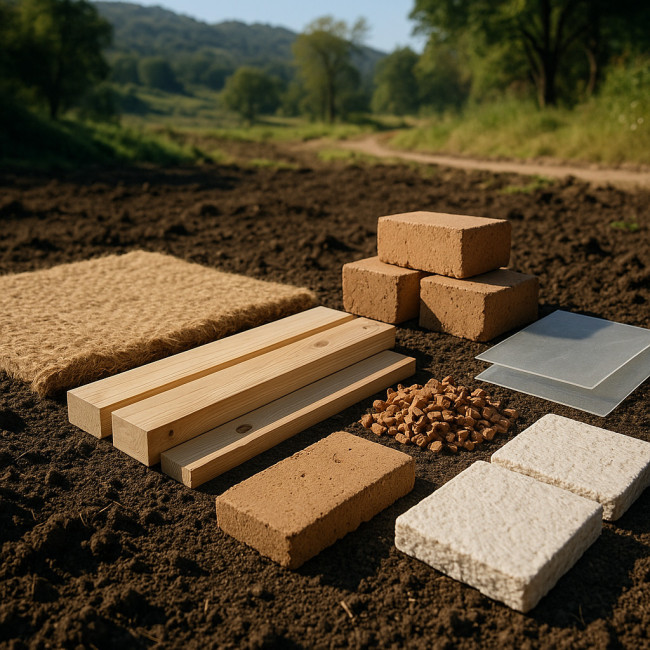Soil-safe materials list to meet restoration clauses and attract eco clients
Need to leave land as pristine as you found it? Our soil-safe materials list gives you proven options that satisfy restoration clauses, minimise remediation costs, and wow eco-conscious clients in one sweep.
Why soil-safe materials are your new non-negotiable
From land-art commissions to temporary festival structures, many briefs now include a “restore the site to original condition” clause. Choosing soil-safe materials up-front:
- Prevents toxic run-off and topsoil damage.
- Speeds up sign-off by environmental inspectors.
- Cuts disposal fees—materials can decompose or be re-used on site.
- Adds a visible green credential that attracts sustainability-minded clients browsing eco-certified craft designers.
Soil-safety criteria you must tick
- Toxin-free composition—no heavy metals, formaldehyde, or halogenated flame retardants.
- pH neutrality—ideally between 6.0 and 8.0 to avoid upsetting microbial life.
- Rapid biodegradation or easy retrieval—material either breaks down within 24 months or can be lifted without residue.
- Low embedded carbon—clients increasingly ask for cradle-to-grave figures.
- Local or recycled sourcing—reduces transport impact and eases permitting.
The definitive soil-safe materials list
Natural fibres that enrich soil
Hemp, jute, and straw mats biodegrade in under 12 months, returning nitrogen and potassium to the ground. They are perfect for erosion control after you dismantle a sculpture mound.
Untreated timber
Use FSC-certified softwood or bamboo that is air-dried, not pressure-treated. Off-cuts can be mulched on site. Pair timber with the low-VOC finishes outlined in sustainable sourcing plans to maintain full soil safety.
Raw earth blends
Adobe bricks, cob, and rammed-earth blocks carry the same mineral profile as surrounding soil, ensuring pH neutrality. When the project ends, simply break them down and rake back into the ground.
Recycled ceramic or brick aggregate
Crushed, un-glazed ceramic offers drainage without chemical leachate. The material also scores well in eco-certification audits when documented as post-consumer waste.
Certified compostable bioplastics (PLA, PHA)
Look for EN 13432 or ASTM D6400 labels. Under industrial composting, PLA degrades in roughly 180 days. Field studies show no microplastic residue after 12 months.
Stone and gravel
Locally quarried granite or sandstone has zero synthetic additives and remains pH neutral. After the show, redistribute stones for on-site path maintenance.
Mycelium composites
Grown from agricultural waste and fungal mycelium, these lightweight panels break down in soil within 45–60 days, leaving only organic matter. They are an eye-catching alternative for clients seeking next-gen eco design.
Soil-safe comparison table
| Material | Typical pH | Full biodegradation (months) | Average cost €/kg | On-site disposal method |
|---|---|---|---|---|
| Hemp mat | 6.2–7.0 | 6–9 | 1.20 | Mulch into topsoil |
| Untreated bamboo | 6.5–7.5 | 24–36 | 0.95 | Chipped for compost |
| Rammed earth | 7.0–7.8 | N/A (native) | 0.08 | Rake back |
| Crushed ceramic | 7.1 | N/A (inert) | 0.15 | Re-grade pathways |
| PLA bioplastic | 6.8 | 6 | 2.10 | Industrial compost |
| Mycelium panel | 6.0–7.0 | 1–2 | 3.60 | Till into soil |
Specifying soil-safe materials in your contract
Insert a dedicated “soil restoration” section that references the above list and spells out:
- Material codes and certifications—e.g., “PLA labelled EN 13432”.
- Disassembly timeline—define the maximum days post-event for removal or mulching.
- Monitoring protocol—soil pH tests one month after project completion.
- Client audits—grant the client or third-party inspector access to receipts and lab certificates.
Need help wording the legal section? Cross-reference the royalty and liability guidance in our eco-smart materials roadmap.
Field-tested implementation tips
Plan for weather
Rain accelerates fibre decomposition. If the project runs over six months, stagger hemp mat installation to keep integrity until teardown.
Colour treatments
When aesthetics matter, choose natural mineral pigments bound with casein. Avoid synthetic dyes that raise soil acidity.
Logistics shortcuts
Partner with a local composting facility to guarantee PLA pickup within 48 hours of dismantle. Their certificate doubles as a marketing proof point.
Case study snapshot

A land artist in Brittany replaced epoxy-sealed plywood with mycelium blocks. The site passed soil testing three weeks after deinstallation, cutting the restoration budget by 38 %. The switch also landed a feature in a regional eco magazine, tripling inbound leads—an outcome similar to the traffic lift discussed in our recycled glass sourcing playbook.
Quick quiz: Could your current material palette pass a soil test?
FAQ
- Can I use pressure-treated wood if I seal it thoroughly?
- No. Copper and arsenic compounds can still leach over time. Choose untreated, FSC-certified timber instead.
- Are biodegradable plastics always soil-safe?
- Only if they hold a compostability certification and are retrieved or composted under the recommended conditions. Otherwise microplastics may linger.
- How do I prove soil-safety to corporate auditors?
- Provide lab pH reports, material invoices, and disposal certificates. A photographic log of dismantling also helps.
- What's the fastest degrading material on the list?
- Mycelium composites—fully broken down in as little as 45 days under moist soil.
- Do stone aggregates ever fail restoration clauses?
- Rarely. Issues arise only if the stone alters drainage patterns. Regrade the area to original topography before hand-over.
Next step: future-proof your material library
Download our extended soil-safe checklist and start updating your spec sheets today. Your eco clients—and the planet—will thank you.
Ready to position yourself as the green choice? Audit one upcoming project with this soil-safe materials list and share the results in your marketing. You'll join the growing roster of creators winning high-value, low-impact briefs.











